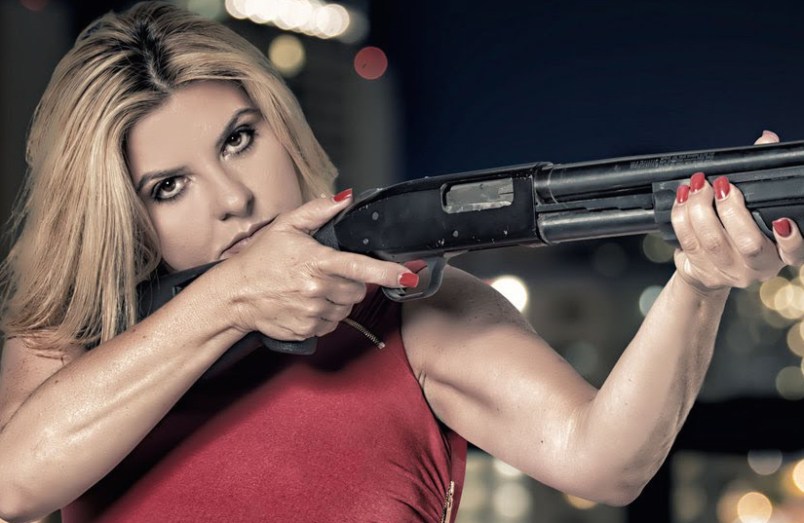She thought she’d be on the phone for a few minutes.
KrisAnne Hall, an attorney and self-proclaimed traveling constitutional educator, had called into a livestream radio show Thursday morning to promote her interpretation of the Constitution and applaud the final occupants at the Malheur Wildlife Refuge for a peaceful end to a more than month-long standoff.
But one man, David Fry, was not ready to go.
“I am actually feeling suicidal right now,” Fry said after the three others had walked out and surrendered to the FBI.
“When he said ‘I am not going,’ for us, there was a moment of silence like we had been punched in the gut,” Hall told TPM the next day.
The saga unfolded for well over an hour as Hall (pictured below) and internet broadcaster Gavin Seim pivoted from constitutional evangelists to mental health counselors. This had not been part of the plan, but they encouraged Fry to walk out of his tent and into law enforcement custody.
When Fry finally gave up, Hall broke down in tears.
“I don’t think I really fully understood the stress of the situation until the FBI turned off the phone, and we knew that he was safe,” Hall said. “You could not see me, obviously, but in my hotel room, my body physically collapsed, and I could not hold back the emotion.”

In the end, it was two women who negotiated the peaceful resolution to the Oregon standoff. With such little trust between the militiamen and the FBI, the women provided a buffer and an alternative path to an end. On Thursday, it was Hall. On Wednesday night, it had been Michele Fiore, a brassy, 45-year-old Second-Amendment-loving Nevada assemblywoman (pictured top), who had convinced the remaining occupiers to surrender and end a 41-day saga.
But the role of women in the Oregon ordeal stretches beyond the contribution of level-headed negotiators. Malheur provided equal-opportunity access for women in the militia and patriot movements to get involved.
While the vast majority of occupiers were men, a handful of women changed the course of the standoff and rose to prominence despite the perception of a right-wing extremist culture dominated by patriarchy. It was an 18-year-old woman who provided one of the first accounts of LaVoy Finicum’s death that was quickly spun into a martyrdom narrative, a woman who acted as a spokesman for the group, a woman who was one of the final four holdouts, and a woman who may have actually kept Fry from hurting himself or others in the end.
“We have historically played a very large role in the defense of liberty so I think what the women were doing in that community was simply being who we were; strong and resolved,” Hall said, claiming that history classes sometimes cover up the role of women in the early days of the country to promote a liberal agenda. “The idea that women are doing this because the men are pointing their fingers and giving orders is ludicrous.”
One of the initial leaders at the refuge was Shawna Cox (pictured right), a woman who had chronicled the 2014 Cliven Bundy standoff against BLM agents in Nevada in a book “Last Rancher Standing.” Cox played a pivotal role in organizing supplies for the dozens of occupiers and serving as a defacto spokeswoman in the first days of the takeover.

It was Cox who stood before the media on Jan. 4, “grabbed a microphone,” and read a “notice of redress of grievance” on behalf of the newly-anointed Citizens for Constitutional Freedom.
While it was common for men at the refuge to have left large families at home in pursuit of adventure in Oregon, Cox, a 59-year-old mother of 12, was unique in that she had come to the refuge by herself while her husband stayed behind in Kanab, Utah.
“She was probalby the leading personality of the women. She had close ties to Ammon and Ryan Bundy, and was one of the standoff veterans,” says Mark Pitcavage, a senior research fellow at the Anti-Defamation League. “She did a lot of the logistics work.”
Cox was riding in the same truck as LaVoy Finicum last month when he fled the FBI and tried to evade a law enforcement roadblock moments before he was shot and killed by state police. She was arrested and charged with “conspiracy to impede federal officers from discharging their official duties through the use of force, intimidation or threats.”
But Cox was not the only woman directly engaged in the confrontation at Malheur.
Eighteen-year-old Victoria Sharp had her role thrust upon her. Sharp, whose single mother had brought her and seven other children to the refuge to sing for the militiamen, was one of the only individuals in the convoy of standoff leaders who was not arrested in the wake of Finicum’s death. She too had been riding in the truck with Finicum on the way to a community meeting. Sharp became a witness, an early voice dictating what had transpired between police and the Arizona rancher. In a recorded interview not long after Finicum’s death, Sharp testified that Finicum had left the vehicle with his hands up when he was killed.
“He got out of the car and he had his hands in the air. He’s like, ‘Just shoot me then!’ And they did. They shot him dead,” she said. “I saw it. I swear to God, just walking with his hands in the air. They just shot him,” she added. “They shot him dead and then after he was down on the ground they shot him three more times.”
Quickly, Finicum became a martyr in the movement, something that egged on the remaining protesters in the final weeks.
One of the final four occupiers, one of the individuals who was actually holed up in a tent in the dead of winter in the vast, southeastern Oregon desert was Sandy Anderson, a 48-year-old former hairdresser– who emerged as one of the toughest minded ideological purists at the standoff.

On Wednesday night before the occupants agreed to surrender, it was Sandy–not her husband Sean Anderson–who was calling the shots.
Clockwise from top left: Oregon standoff participants Sandy Anderson, Sean Anderson, Jeff Banta and David Fry
“I am not going to jail for standing up for my rights,” Sandy Anderson said.
Her husband then chimed in, “If my wife says she’s not leaving, I’m not leaving.”
In the end, Anderson did turn herself over to police.
Oregon was not the first time that women played a critical role in an anti-government occupation, however.
“There always seems to be repeated surprise whenever women are found to be involved in right wing extremism,” Pitcavage says. “A great many women are involved in these movements and the roles that they play may differ from movement to movement and group to group, but they are always present.”
Pivcavage points out that if you go back to Ruby Ridge in 1992, Vicki Weaver, Randy Weaver’s wife who is shot and killed, is “every bit as adamant if not more so than Randy Weaver” about their subscribed ideology. And in the Montana Freemen standoff in the 1990s, Dana Dudley Landers – a member of the sovereign citizens movement– was one of the more hardcore occupiers who was on the run from charges in Colorado, according to CNN.










…a brassy, 45-year-old Second-Amendment -loving Nevada assemblywomen…
That’s one hell of a charitable description of Michele Fiore, Miss Fox.
I think Ms. Fox is giving this NRA-funded media whore way too much credit. Chickenshit Fry would’ve come out with or without Hall’s presence, if nothing else due his desire to again wear a pair un-soiled underwear.
Indeed, I think Hall displayed her classlessness by not inviting Oily Taint to accompany her to the show. Talk about a glory hog.
Ugh.
Not sure why…
I feel like I just accidentally clicked on a “suggested for you sponsored content” pane on the bottom of cnn.
the one thing I’d give Ms Fiore credit for is drawing Pappy Cliven out to face his arrest warrant…
TPM, east of Huffington Post, just past People Magazine.